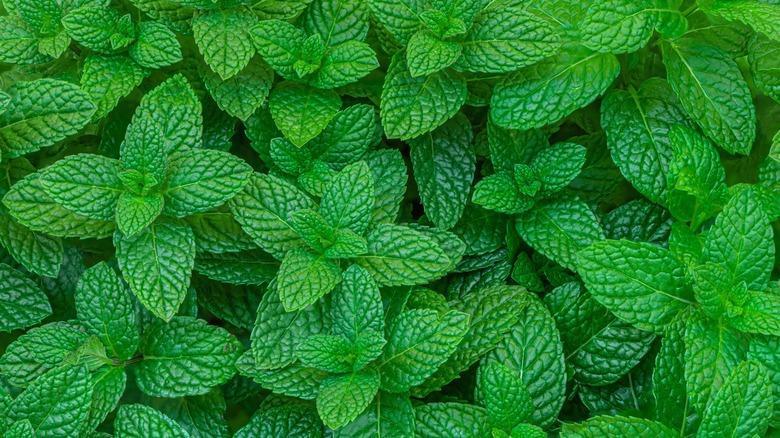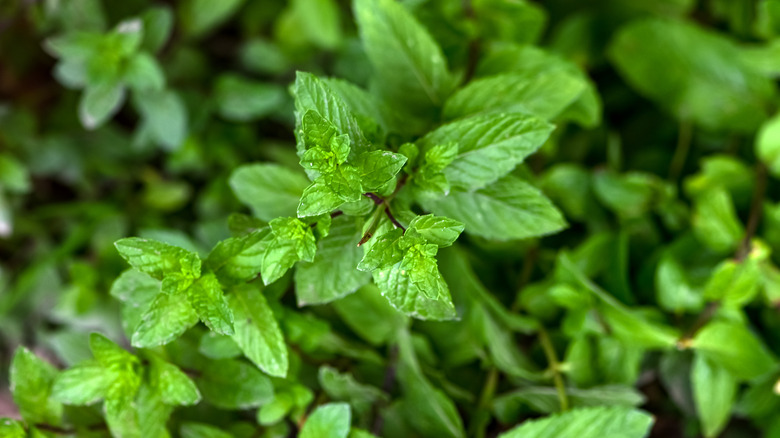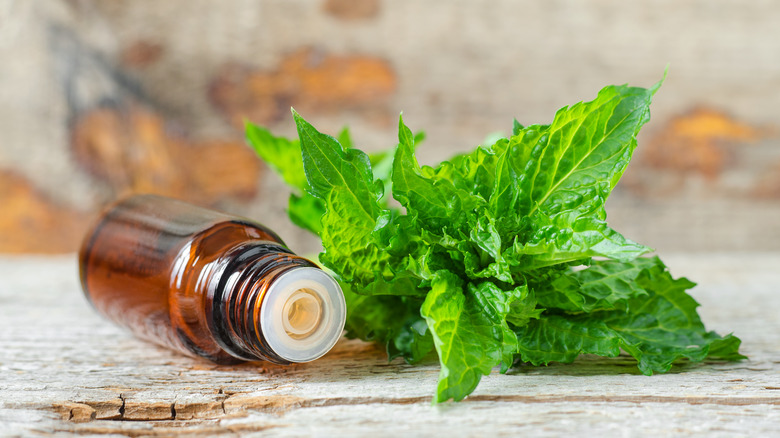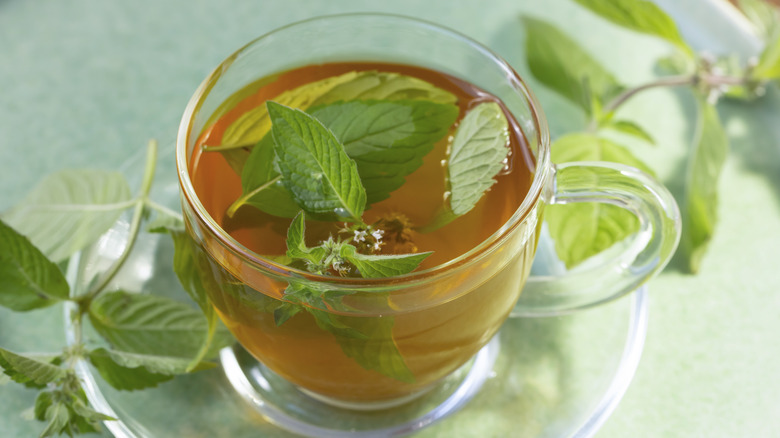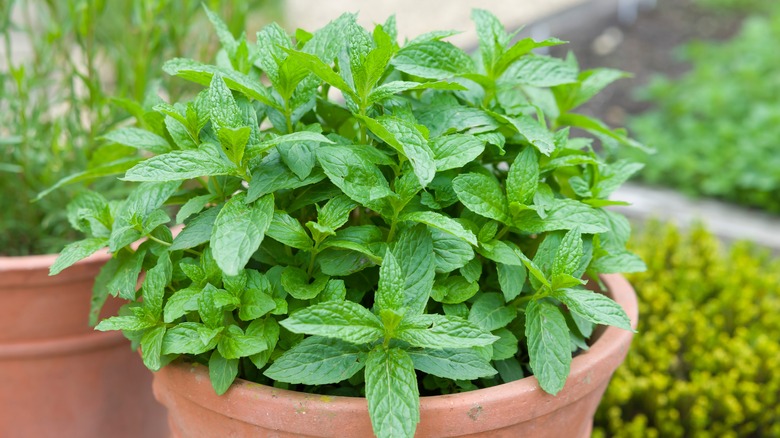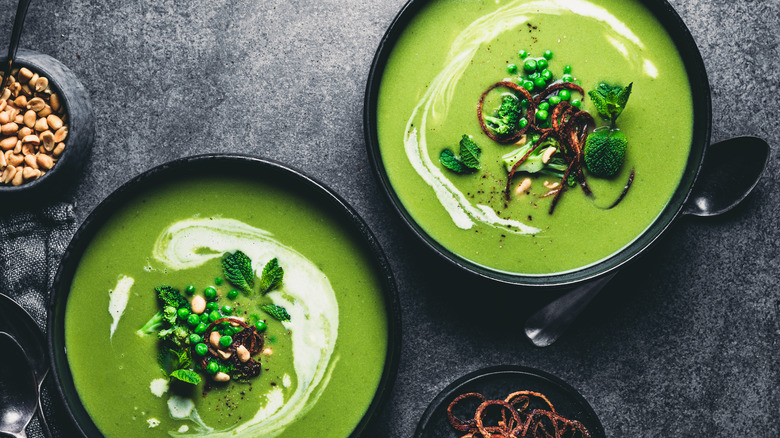Peppermint Vs Spearmint: The Differences Everyone Should Know
Tiny details in a recipe can make or break a delicious dish. Have you ever accidentally added three tablespoons of salt instead of three teaspoons? It makes a big difference. A common predicament when working with food recipes is when they're not very detailed. For example: when a recipe calls for mint, which kind should you use? There are actually over 600 types of mint to choose from. When it comes to mint, most people know about peppermint and spearmint thanks to candy canes, breath mints, toothpaste, mint chocolate chip ice cream, and many other everyday foods and drinks. Some folks might even mistake spearmint and peppermint to be the same thing — but this is far from reality.
Spearmint and peppermint are two very distinct plants, with some similarities, but far more differences. Both plants are in the mint family, which contains over 7,000 different species of plants, including other common kitchen herbs like sage and rosemary. Herbs in the mint family are highly aromatic plants, with square stems and opposite leaves, but that's about where the similarities between spearmint and peppermint end. On the surface, these two plants might seem the same; but upon closer inspection, there are many subtle, unique differentiations between the two. Learning these differences can help you decide which plant works best in the dish you are creating.
What is peppermint?
Every plant has a Latin name to help with identification and differentiate between plant species. The Latin name for peppermint is Mentha piperita. Interestingly, the peppermint plant is a natural hybridization combination of spearmint, whose Latin name is Mentha spicata, and watermint, Mentha aquatic; which means that a little bit of spearmint's genetic makeup is inside peppermint. This aromatic perennial plant is thought to be native to Europe and the Mediterranean, but it now grows throughout Europe and North America, cultivated in gardens and sneaking into wild spaces, meadows, and along sidewalks.
The peppermint plant contains volatile oils in its leaves and stems that give this plant its token smell and flavor profile. The oils are extracted through a steam distillation process, then sold as an essential oil, or added to sweets, chewing gum, jellies, sauces, and more. Peppermint oil is also commonly used in the tobacco industry to make menthol cigarettes. Peppermint is a common ingredient found in household products like soaps, cleaners, toothpastes, lotions, and more; although sometimes an artificial representation of the natural peppermint oil is used to recreate this well-known aromatic profile.
What is spearmint?
Spearmint also contains many volatile oils in its leaves and stems, like peppermint, which makes this perennial plant highly aromatic and flavorful. You are probably also very familiar with spearmint, as it is highly sought after as a common ingredient in many topical products, foods, and beverages on the market. Spearmint oil or artificial flavorings are often found inside toothpaste, mouthwash, candies, and other foods and beverages. Maybe you're familiar with the classic Wrigley's Spearmint gum?
Spearmint is believed to be a cross between two different mint species, horsemint (Mentha longifolia) and pineapple mint (Mentha suaveolens). The spearmint plant, or Mentha spicata, is native to Europe and Asia, but can now be found growing almost worldwide across five different continents. The Latin word "spicata" means spiked, which refers to the natural spiked edges of this plant's spear-shaped leaves — hence its name. Peppermint leaves are more rounded than tapered and spiky, both on the edges and tips of the leaves.
Peppermint has more menthol
Contrary to popular belief, peppermint actually smells dramatically different compared to spearmint. Peppermint and spearmint have very different aromatic profiles due to the differences in the volatile oils they contain; most notably with menthol — peppermint contains 80 times more menthol than spearmint! Menthol is an organic aromatic compound, also known as a monoterpene, that causes a noticeable numbing and cooling sensation when consumed or put on the body. When it comes to volatile oil content, spearmint contains only about 0.5% menthol, while peppermint has a whopping 40%. Peppermint also contains pulegone, menthone, cineol, and other volatile oils.
When consuming peppermint, you might notice a way more profound cooling effect compared to spearmint. That's because most of the aroma and flavor of spearmint comes from the volatile compound carvone, which makes up over half of the total amount of volatile oils in this plant. Carvone is considered less intense and more subdued than menthol. Other volatile oils in spearmint include limonene, dillapiole, and a few others.
Spearmint is more subtle and sweet
Differing flavor is another one of the main ways you can tell peppermint and spearmint apart. Peppermint gets its name from the Latin word "piperita," which means "peppery," a nod to its spicy, pepper-like flavor. This intense and sharp flavor comes from the high menthol content in the plant. When peppermint is an ingredient in something, it's almost impossible to miss, as menthol loves to be the star of the show whenever peppermint is involved. The strong, bold, and refreshing flavor of peppermint is invigorating to the senses and leaves an unforgettable mark on the palette.
On the other hand, the subtleties of spearmint often fly under the radar, working to complement flavors but never to steal the spotlight. Spearmint has a lighter and sweeter flavor, thanks to its prominent volatile compound, carvone. Spearmint is delicate, earthy, and slightly minty, but not too overpowering.
Peppermint is more commonly used in baking and sweet dishes
Both peppermint and spearmint are used in a variety of culinary dishes and drinks, but their stark differences in flavor and aroma suggest that each plant pairs better with different flavors. Peppermint is a popular holiday flavor, and there's a reason it's found in a lot of holiday treats. The prominent and strong flavor of peppermint pairs nicely with baked goods, as the spiciness of peppermint helps balance out the sugary sweetness, making it a go-to ingredient in sweet treats and really, any recipe that involves chocolate.
Think peppermint chocolate truffle cookies, creamy peppermint hot chocolate with marshmallows, and yummy peppermint bark. The next time you're feeling creative in the kitchen during the holidays, you could make a spin on the classic puppy chow — also known as muddy buddies, depending on what part of the world you live in – and use white chocolate and peppermint candy canes to make peppermint Christmas puppy chow.
Spearmint is more commonly used in savory dishes
Unlike its peppermint relative, spearmint is often incorporated in more savory than sweet dishes – like pesto, dips, and pasta sauces — due to its slightly sweet taste and subtle flavor profile. Spearmint pairs well with citrus fruits, cucumbers, and savory foods. It's often used as a garnish for beverages or roasted vegetable dishes. It's a great ingredient in herbal sauces slathered over chicken or lamb, inside a citrus fruit medley, or tucked inside a shrimp or tofu salad roll.
Spearmint is also the go-to mint for the classic mojito drink, as the delicate, lightly sweet spearmint flavor pairs well with the sugar, lime, and seltzer. Attempting to use peppermint in a mojito might be too overpowering, resulting in unbalanced flavors and leaving you with a spicy, intense beverage that's hard to finish. Spearmint is a good accent ingredient and doesn't take over a dish, making it a highly versatile herb that can be used in a wide variety of culinary dishes.
Peppermint has different health benefits
Both spearmint and peppermint are common ingredients in herbal remedies and are often used to make herbal tea. Both plants are believed to contain vitamins, antioxidants, nutrients, and some health benefits. Because peppermint shares some DNA with spearmint, both plants have some similarities in health benefits. Both spearmint and peppermint are traditionally used for digestive complaints – specifically indigestion, gas, bloating, nausea, and vomiting. Both plants are also thought to contain some mild pain-relieving properties. In fact, one scientific study found that applying diluted peppermint essential oil to the forehead helped soothe tension headaches and migraines, while a different study suggested spearmint may help ease arthritis pain.
However, peppermint is considered far more effective in supporting the respiratory system when compared to spearmint. The high amount of menthol found in peppermint can help open up the lungs and clear out congestion, making it easier to breathe. For this reason, peppermint essential oil is commonly used in an herbal steam to help alleviate cold and flu symptoms, coughs, or allergy symptoms.
Spearmint is more of a sedative
In Western herbalism, peppermint is often considered a stimulant, while spearmint is classified as a sedative. This is not to say that peppermint acts like caffeine and is similar to drinking a cup of coffee, or that spearmint is going to act like a sleeping pill. Here, the word "stimulant" describes an herbal action of a plant that stimulates mental activity and energy, meaning that peppermint has the potential to help increase focus and concentration, uplift your mood, and naturally boost energy, but not in a jittery, over-caffeinated kind of way. The refreshing scent of peppermint is thought to "wake up" or invigorate the mind and body.
Spearmint, on the other hand, is more relaxing and gentle and is actually thought to help reduce stress and anxiety and promote better sleep at night, which has been backed up by science. Some South American countries traditionally use spearmint to address insomnia and stress issues.
Can you substitute one for the other?
While peppermint and spearmint may seem quite similar on the surface level, their subtle differences make it hard to substitute one for the other. The key takeaway here is that peppermint is best suited for sweets, while spearmint is great for savory foods. The strong menthol flavor and aroma of peppermint cause it to be quite spicy, making it a key ingredient in balancing the sweetness of baked goods, while the sweet subtlety of spearmint makes it a great accent ingredient in savory dishes.
However, the subdued flavor and aroma of spearmint make it a versatile ingredient that really does well in a variety of dishes, including some sweets. Of course, there can be some crossover here and there are no hard lines in the kitchen. You are welcome to play around with different recipes and discover what you like best. Use this guide as a jumping-off point to experiment in the kitchen and have fun!

